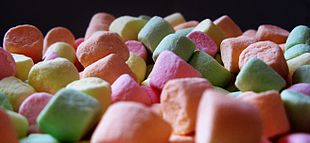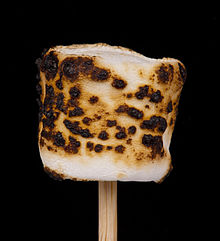- Marshmallow
-
The marshmallow is a confection that, in its modern form, typically consists of sugar, corn syrup, water, gelatin that has been softened in hot water, dextrose, vanilla flavourings, and sometimes colouring, whipped to a spongy consistency. Some marshmallow recipes call for egg whites.[1] This confection is the modern version of a medicinal confection made from Althaea officinalis, the marshmallow plant.[1]
Contents
Production history
The marshmallow probably first came into being as a medicinal substance, since the mucilaginous extracts comes from the root of the marshmallow plant, Althaea officinalis, which were used as a remedy for sore throats. Concoctions of other parts of the marshmallow plant had medical uses as well.[2] The root has been used since Egyptian antiquity in a honey-sweetened confection useful in the treatment of sore throat.[1] The later French version of the recipe, called pâte de guimauve (or "guimauve" for short), included an egg white meringue and was often flavored with rose water. Pâte de guimauve more closely resembles contemporary commercially available marshmallows, which no longer contain any marshmallow plant.
The use of marshmallow to make a candy dates back to ancient Egypt, where the recipe called for extracting sap from the plant and mixing it with nuts and honey. Another pre-modern recipe uses the pith of the marshmallow plant, rather than the sap. The stem was peeled back to reveal the soft and spongy pith, which was boiled in sugar syrup and dried to produce a soft, chewy confection.[2] Candymakers in early 19th century France made the innovation of whipping up the marshmallow sap and sweetening it, to make a confection similar to modern marshmallow. The confection was made locally, however, by the owners of small candy stores. They would extract the sap from the mallow plant's root, and whip it themselves. The candy was very popular, but its manufacture was labor-intensive. In the late 19th century, French manufacturers devised a way to get around this by using egg whites or gelatin, combined with modified corn starch, to create the chewy base. This avoided the laborious extraction process, but it did require industrial methods to combine the gelatin and corn starch in the right way.[2][3] Also related are the German confectionery called Schaumkuss.
Another milestone in the development of the modern marshmallow was the extrusion process by the American Alex Doumak in 1948. This invention allowed marshmallows to be manufactured in a fully automated way. The method produced the cylindrical shape that are now associated with marshmallows. The process involves running the ingredients through tubes and then extruding the finished product as a soft cylinder, which is then cut into sections and rolled in a mixture of finely powdered cornstarch and confectioner's sugar. Doumak founded the Doumak company in 1961 on the strength of his patent on this process.[3]
Marshmallows, like most candies, are sweetened with sucrose. They are currently prepared by aeration of mixtures of sucrose and proteins to a final density of about 0.5 g/mL. The viscosity of the mixture, owing to the proteins, gelatin or egg albumin, prevents collapse of the air-filled cells.[4]
Brands
Most of the current brands of commercially available marshmallows in the United States are made and copacked by Kraft Foods and Doumak, Inc, under such names as Jet-Puffed, Campfire, Kidd and numerous "private label" store brands.[citation needed] Marshmallows are used in S'mores, Mallomars and other chocolate-coated treats, Peeps, Whippets and other sweets, Rice Krispies treats, ice cream flavors such as Rocky Road, as a topping for hot chocolate, candied yams, and in several other foodstuffs.
Marshmallows are manufactured in the United Kingdom by, amongst others, Haribo, Barrett, Princess, and numerous 'non' brand companies including shops and supermarkets.[citation needed]
Marshmallows are popular in Asia, particularly in the previous colonies of the UK.[citation needed] One of the largest suppliers in Asia is Erko Foods, based in China. The company exports to 56 countries. Erko is also the market leader in the Middle East, where their Halal marshmallow is sold.
Roasted marshmallows
A popular camping or backyard tradition is the roasting or toasting of marshmallows over a campfire or other open flame.[5] A marshmallow is placed on the end of a stick or skewer and held carefully over the fire. This creates a caramelized outer skin with a liquid, molten layer underneath. According to individual preference, the marshmallows are heated to various degrees—from gently toasted to a charred outer layer. The roasted marshmallow can either be eaten whole or the outer layer can be consumed separately and the rest of the marshmallow toasted again.
S'mores are made by placing a toasted marshmallow on a slice of chocolate which is then placed between two graham crackers.[6]
Dietary preferences
The traditional marshmallow recipe uses powdered marshmallow root, which may be difficult to obtain. Most commercially manufactured marshmallows instead use gelatin in their manufacture, which vegetarians avoid, as it is derived from animal hides and bones. Marshmallows are also generally considered not to be kosher or halal unless their gelatin is derived from kosher or halal animals, or the marshmallows are vegetarian. An alternative for vegetarians is to use substitute non-meat gelling agents such as agar for gelatin.
Marshmallow creme and other less firm marshmallow products generally contain little or no gelatin, which mainly serves to allow the familiar marshmallow confection to retain its shape. They generally use egg whites instead. Non-gelatin versions of this product may be consumed by ovo vegetarians. Several brands of vegan marshmallows and marshmallow fluff exist.
See also
- Chocolate-coated marshmallow treats
- Chubby Bunny, children's game involving marshmallows
- Marshmallow creme
- Stay Puft Marshmallow Man
References
- ^ a b c Petkewich, Rachel (2006). "What's that stuff? Marshmallow". Chemical & Engineering News 84 (16): 41. doi:10.1021/cen-v084n011.p041. http://pubs.acs.org/cen/whatstuff/84/8416marshmallows.html. Retrieved 2008-02-10.
- ^ a b c Rohde, Eleanour Sinclair; A garden of Herbs, Hale Cushman & Flint, 1936
- ^ a b The history of marshmallows Candy USA!
- ^ Terry Richardson, Geert Andersen, "Confectionery" in Ullmann's Encyclopedia of Industrial Chemistry 2005 Wiley-VCH, Weinheim. doi:10.1002/14356007.a07 411
- ^ History of Campfire Marshmallows
- ^ Merriam-Webster Online Dictionary
External links
- How To Make Your Own Marshmallows
- The Marshmallow Explained at HowStuffWorks.com
Categories:- Confectionery
- Marshmallows
- Skewered foods
Wikimedia Foundation. 2010.


